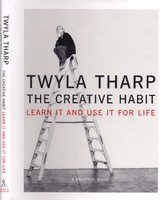| |
The Creative Habit

Twyla Tharp's The Creative Habit provides a guided tour of the creative process. She is famous for her choreography, but Tharp is also a stimulating writer. Is she qualified to write on creativity? Listen to these words from her introduction: I'm a dancer and choreographer. Over the last 35 years, I've created 130 dances and ballets. Some of them are good, some less good (that's an understatement--some were public humiliations). I've worked with dancers in almost every space and environment you can imagine. I've rehearsed in cow pastures. I've rehearsed in hundreds of studios, some luxurious in their austerity and expansiveness, others filthy and gritty, with rodents literally racing around the edges of the room. . . . I've worked with dancers in the opera houses of London, Paris, Stockholm, Sydney, and Berlin. I've run my own company for three decades. I've created and directed a hit show on Broadway. I've worked long enough and produced with sufficient consistency that by now I find not only challenge and trepidation but peace as well as promise in the empty white room. It has become my home." As you might guess from the book's title, Tharp believes creativity does not just come naturally. Consistently creative people practice disciplined routines. "Creativity is a habit, and the best creativity is a result of good work habits." Building on stories from her own experience and those of her friends, Tharp offers practical guidance. Each chapter concludes with exercises, and yes, they are creative. As people made in the image of the Creator God, creativity is part of our calling. It brings richness and dimension to life. It enables us to live expansively in a world of endless possibility. Bob
Weavings
The Weavings journal for March/April 2002 is open on my desk. Its topic is Creativity. The journal last month was on Mystery. It spurred me to teach, last week in church, on recovering a biblical sense of mystery. If you do not subscribe to Weavings, visit www.upperroom.org and get a subscription. It comes bimonthly and includes insightful writings from a wide variety of authors. Each edition centers around a topic. Essays, poetry, short stories, and more deliver a smorgasborg of delight. In the Creativity edition, Wendy Wright writes of visiting her second daughter for the first time at college. Hear her words from "Potter and Clay": What is the formative lesson of this autumn tide of my life? What is it to let the soft clay of my being be re-formed by the process of this second daughter's springtime flowering, her moving away? She was fashioned first inside me, took shape all those years under my nurturing hands. Now I open them wide and let her go, the fruit of this harvest season. What deep roots, stretching into hidden groundwaters, will the coming season of winter bring? Good writing. A publication that I kept for reference now four years later. Valuable. Joni
Saint Ralph
 My husband has classic stories from his days in Catholic school in southern California. When he gets together with old school friends, they laugh until they cry. If you have those memories or are attached to someone who does...or if you were a boy or know someone who was a boy...rent the new DVD, Saint Ralph. It is the story of a boy in Catholic school who believes winning the Boston marathon will save his terminally ill mother. One priest is his reluctant champion. Another is his nemesis. The humor is a bit rowdy around the edges, but it comes on strong throughout. A story of how far faith will take you. Joni
Peace Like a River
 Our new friends, Blanche and Robert Jenson, insisted we read Leif Enger's novel, Peace Like A River. We must now insist that you read it also. Superb writing. A vision of God's sufficient grace through life's convoluted journey. "Where do we go from here? He didn't know. We'd simply go forth, he said, like the children of Israel when they packed up and cameled out of Egypt. He meant to encourage me. Just like us, the Israelites hadn't any idea where they'd end up! Just like us, they were traveling by faith! Indeed, it did impart a thrill, yet the trip thus far, in the frigid and torpid Plymouth, had reminded me of what a hard time the chosen people actually had of it. Once traveling, it's remarkable how quickly faith erodes. It starts to look like something else - ignorance, for example. Same thing happened to the Israelites. Sure it's weak, but sometimes you'd rather just have a map." Reuben, the young boy riding in the frigid Plymouth, has seen his father perform miracles: walking on air, healing a pock-marked face, restoring leather rent in two. His father had commandingly charged Reuben to "in the name of God, breathe!" at the moment of his birth. And Reuben breathed! He was too scared to do otherwise. The metaphor of breathing runs through the story as a marker of life and death. The family needs a miracle as they ramble through the countryside, hoping to find a prodigal son. They travel pulling an Airstream trailer that was the gift of a dead man. Sister Swede chronicles the adventure through her Wild West poems. Reuben wishes for a simple miracle to make the family whole again. Or perhaps a map leading him in a straight line to the answers. Restoration comes through ragged, broken people, through forgiveness of large and small sins, and through the sting of death mingled with the victory of life. The book ends with Reuben witnessing to his journey through this life and beyond into the next: "Is there a single person on whom I can press belief? No sir. All I can do is say, Here's how it went. Here's what I saw. I've been there and am going back. Make of it what you will."
|
    |



